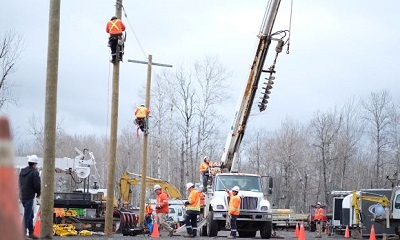 Friday, July 26, 2024
Friday, July 26, 2024  Friday, July 26, 2024
Friday, July 26, 2024 
Got news? Next submission deadline is Friday at 5:00 p.m.
Click here to submit YOUR news

“It would mean to me that I am worth something.”
That’s why Anthony Begg wants a job on the Wataynikaneyap Power Project.
Begg, 24, is one of a dozen trainees taking a two-week “work readiness” course in Kingfisher Lake, Ont.
Located about 500 kilometres north of Thunder Bay with no road access, Kingfisher Lake — population 350 — is as remote a community as there is in this country.
The training course doesn’t guarantee Begg work on the $1.6-billion project, but it brings hope to a region with an unemployment rate seven times the national average.
“It’s like a second chance to rebuild my life,” says Begg, who dropped out of school part-way through Grade 11.
“I didn’t finish, because in my teenage years I was heavily in my addiction, like drinking and drugs and all that stupid stuff.”
Begg ended up in jail for assault, but says prison changed him for the better.
“I looked around my surroundings and I thought to myself, ‘I don’t want to be like these people. I want to work.'”
Electricity in Kingfisher Lake comes from a trio of diesel generators.
This is reality for almost all of the First Nations communities that dot an area of northwestern Ontario about the size of France.
An economic study by Ontario’s Independent Electricity System Operator (IESO) published in 2014 put the cost of supplying diesel to 21 remote communities in northwestern Ontario at around $90 million a year. Most of that is paid for by the federal government and Ontario’s electricity consumers.
The same study makes the case that connecting those communities to the grid would save up to $1 billion in fuel costs alone over the next 40 years. The IESO states that using diesel to create electricity in remote communities is, on average, the highest-cost electricity resource in Ontario.
The Wataynikaneyap project involves putting poles in the ground for 1,800 km of transmission lines that will connect 17 remote First Nations communities to Ontario’s power grid. It will cut the cost of providing electricity to northern communities, and means 260 jobs in the region for people who will build the lines and maintain them.
In Kingfisher Lake, 29-year old Nathan Singleton is eager to see the project link his community to the Ontario grid. He’s not just anticipating a job — he hopes the project will help fix the housing crisis.
Watch the video and learn more about the benefits of joining Construction Links Network – the peer-to-peer network sharing platform for the construction, building and design community.
Ideal for YOUR Press Releases | Project Updates | New Appointments | Awards & Milestones | Company News | New Products/Services | Brochures | Videos | Infographics | Blog Sharing | Events and More